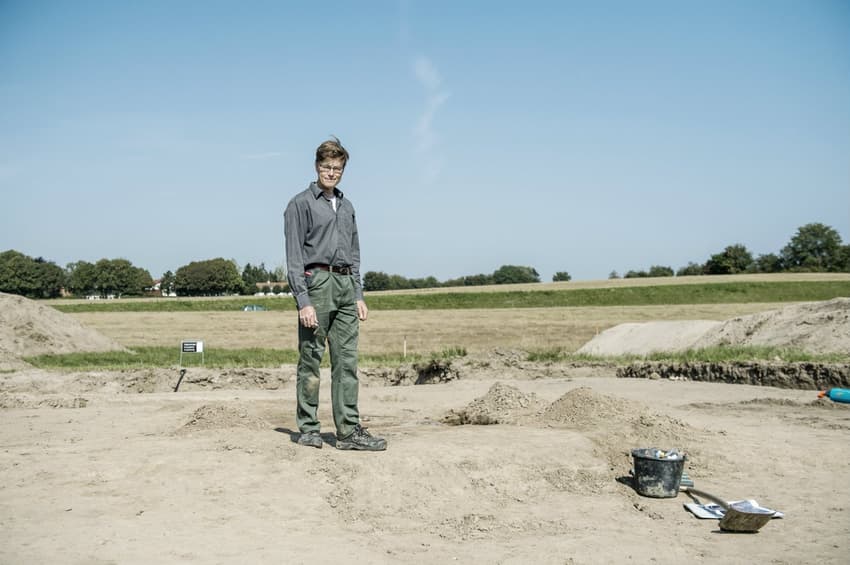Denmark find proves 'Harald Bluetooth’s fifth Viking fortress'

Archaeologists have found a stump of wood that suggests that Denmark’s fifth Viking ring fortress originated in the time of Harald Bluetooth.
The fifth Viking fortress was discovered near a motorway west of the Zealand town of Køge in 2014.
The five castles, also known as ring forts due to their circular designs, were built by Harold Bluetooth at strategic locations around Denmark.
Since the discovery of the fifth fortress, there has been much debate as to whether it was built during the time of the famous Viking ruler, who reigned over Denmark and Norway lived from approx. 935-986 C.E.
Archaeologists now appear to have found an answer to the question.
Last week a stump of wood was found that was able to be dated to the period in which Harald Bluetooth ruled over the kingdom, reports newspaper Politiken.
“This is our biggest breakthrough since the discovery in 2014,” Søren Sindbæk, professor of archaeology at Aarhus University and a researcher at the Køge site, told Politiken.
READ ALSO: After 1,000 years, ‘forgotten' Danish Viking fortress opens
Sindbæk said that the discovery of the wooden stump was a “smoking gun” proving that a large structure with a palisade and four gates at the fortress was built during the 10th century – the same period as Denmark’s four other ring forts.
Since its discovery, many researchers have been in doubt as to the connection between the Køge fortress and Denmark’s four famous ring fortresses from the Viking period.
“Many have been critical and said that this does not belong together with the other castles. Personally, I have always believed that it belonged to the same group, in part because of its geometry,” Sindbæk said.
Excavation leader Nanna Holm also supported the conclusion of the new discovery.
“We simply don’t know any other complexes with this form. This is important for us because it’s one more thing in the box of evidence,” Holm told Politiken.
The fragment of wood was found when the researchers began excavating in a river valley south of the castle last week.
Using a North Europe-wide database of oak samples and by comparing with one of the other four Viking ring fortresses, at Trelleborg, the team concluded that the tree the wood came from grew in Denmark and was felled after the year 966.
Although the castle appears to have been erected during the time of Harald Bluetooth, it is currently too early to officially credit the Viking king with building it.
The castle could also have been built by Harald’s enemies, according to the report.
“In theory, the castle could have been built by Sweyn Forkbeard, but that seems unlikely,” Sindbæk told Politiken.
Comments
See Also
The fifth Viking fortress was discovered near a motorway west of the Zealand town of Køge in 2014.
The five castles, also known as ring forts due to their circular designs, were built by Harold Bluetooth at strategic locations around Denmark.
Since the discovery of the fifth fortress, there has been much debate as to whether it was built during the time of the famous Viking ruler, who reigned over Denmark and Norway lived from approx. 935-986 C.E.
Archaeologists now appear to have found an answer to the question.
Last week a stump of wood was found that was able to be dated to the period in which Harald Bluetooth ruled over the kingdom, reports newspaper Politiken.
“This is our biggest breakthrough since the discovery in 2014,” Søren Sindbæk, professor of archaeology at Aarhus University and a researcher at the Køge site, told Politiken.
READ ALSO: After 1,000 years, ‘forgotten' Danish Viking fortress opens
Sindbæk said that the discovery of the wooden stump was a “smoking gun” proving that a large structure with a palisade and four gates at the fortress was built during the 10th century – the same period as Denmark’s four other ring forts.
Since its discovery, many researchers have been in doubt as to the connection between the Køge fortress and Denmark’s four famous ring fortresses from the Viking period.
“Many have been critical and said that this does not belong together with the other castles. Personally, I have always believed that it belonged to the same group, in part because of its geometry,” Sindbæk said.
Excavation leader Nanna Holm also supported the conclusion of the new discovery.
“We simply don’t know any other complexes with this form. This is important for us because it’s one more thing in the box of evidence,” Holm told Politiken.
The fragment of wood was found when the researchers began excavating in a river valley south of the castle last week.
Using a North Europe-wide database of oak samples and by comparing with one of the other four Viking ring fortresses, at Trelleborg, the team concluded that the tree the wood came from grew in Denmark and was felled after the year 966.
Although the castle appears to have been erected during the time of Harald Bluetooth, it is currently too early to officially credit the Viking king with building it.
The castle could also have been built by Harald’s enemies, according to the report.
“In theory, the castle could have been built by Sweyn Forkbeard, but that seems unlikely,” Sindbæk told Politiken.
Join the conversation in our comments section below. Share your own views and experience and if you have a question or suggestion for our journalists then email us at [email protected].
Please keep comments civil, constructive and on topic – and make sure to read our terms of use before getting involved.
Please log in here to leave a comment.